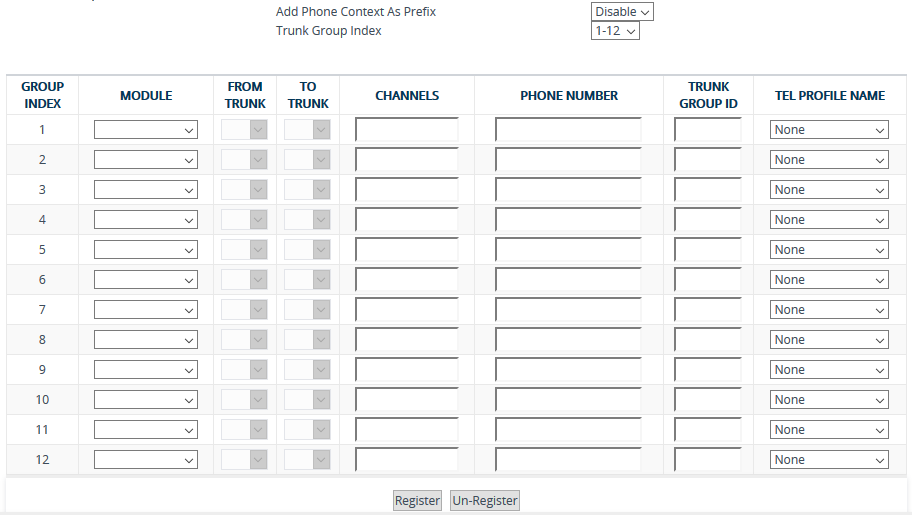Configuring Trunk Groups
The Trunk Groups table lets you configure up to
Once you have configured your Trunk Group, you can use it for call routing. To configure IP-to-Tel routing rules, see Configuring IP-to-Tel Routing Rules. To configure Tel-to-IP routing rules, see Configuring Tel-to-IP Routing Rules.
The following procedure describes how to configure Trunk Groups through the Web interface. You can also configure it through ini file [TrunkGroup_x] or CLI (configure voip > gateway trunk-group).
It's recommended notto configure a Trunk Group with Trunk Group ID 0. A Trunk Group with ID 0 doesn't support some of the device's features (e.g., not counted in performance monitoring).
| ➢ | To configure a Trunk Group: |
| 1. | Open the Trunk Groups table (Setup menu > Signaling & Media tab > Gateway folder > Trunks & Groups > Trunk Groups). |

| 2. | Configure a Trunk Group according to the parameters described in the table below. |
| 3. | Click Apply. |
You can also register all your Trunk Groups. The registration method per Trunk Group is configured by the 'Registration Mode' parameter in the Trunk Group Settings page (see Configuring Trunk Group Settings).
| ■ | To register Trunk Groups, click the Register button. |
| ■ | To unregister Trunk Groups, click the Unregister button. |
Trunk Group Table Parameter Descriptions
|
Parameter |
Description |
|||||||||
|---|---|---|---|---|---|---|---|---|---|---|
|
'Module' module [Module] |
Defines the |
|||||||||
|
'From Trunk' first-trunk-id [FirstTrunkId] |
Defines the starting physical Trunk number in the Trunk Group. The number of listed Trunks depends on the device's hardware configuration. Note: The parameter is applicable only to digital interfaces. |
|||||||||
|
'To Trunk' last-trunk-id [LastTrunkId] |
Defines the ending physical Trunk number in the Trunk Group. The number of listed Trunks depends on the device's hardware configuration. Note: The parameter is applicable only to digital interfaces. |
|||||||||
|
'Channels' first-b-channel [FirstBChannel] last-b-channel [LastBChannel] |
To enable channels, enter the channel numbers. You can enter a range of channels by using the syntax n-m, where n represents the lower channel number and m the higher channel number. For example, "1-4" (without quotation marks) specifies channels 1 through 4. Note: For digital interface, the number of defined channels must not exceed the maximum number of the Trunk’s B-channels. |
|||||||||
|
'Phone Number' first-phone-number [FirstPhoneNumber] |
Defines the telephone number(s) of the channels. The valid value can be up to 50 characters. For a range of channels, enter only the first telephone number. Subsequent channels are assigned the next consecutive telephone number. For example, if you enter 400 for channels 1 to 4, then channel 1 is assigned phone number 400, channel 2 is assigned phone number 401, and so on. These numbers are also used for channel allocation for IP-to-Tel calls if the Trunk Group’s ‘Channel Select Mode’ parameter is set to By Dest Phone Number. Note:
|
|||||||||
|
'Trunk Group ID' trunk-group-id [TrunkGroupNum] |
Defines the Trunk Group ID for the specified channels. The same Trunk Group ID can be assigned to more than one group of channels. If an IP-to-Tel call is assigned to a Trunk Group, the IP call is routed to the channel(s) pertaining to that Trunk Group ID. The valid value can be 0 to Note: Currently, Trunk Group ID #0 is not counted in the device's performance monitoring and no SNMP alarms are sent for it. |
|||||||||
|
'Tel Profile Name' tel-profile-id [ProfileName] |
Assigns a Tel Profile to the Trunk Group. To configure Tel Profiles, see Configuring Tel Profiles. |